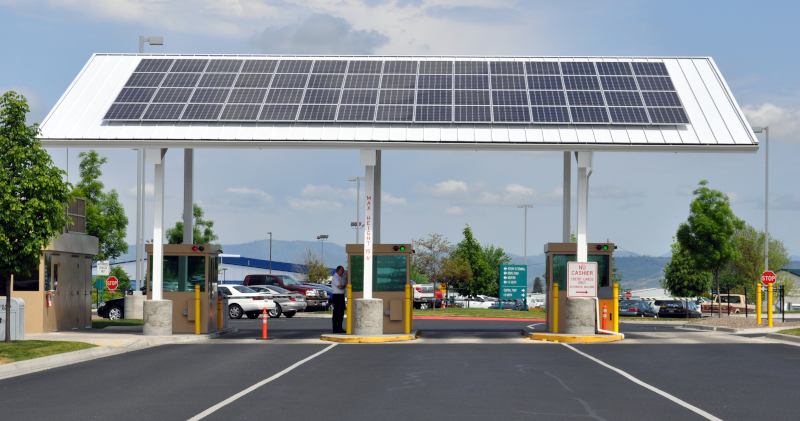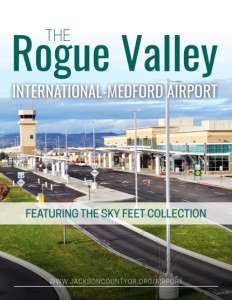The Rogue Valley International-Medford Airport
Featuring the Sky Feet collection
Business View Magazine interviews Jerry Brienza, Airport Director at the Rogue Valley Int.-Medford Airport, as part of our series on regional American airports.
The Rogue Valley International-Medford Airport is a public-use airport located three miles north of downtown Medford, a city in Jackson County, Oregon. Owned and operated by Jackson County’s Airport Authority, the Airport was originally named Medford–Jackson County Airport and was renamed Rogue Valley International–Medford Airport after it became an international airport in 1994. The Airport covers 905 acres at an elevation of 1,335 feet; its asphalt runway, 14/32, is 8,800 by 150 feet. In June 2018, the airport was reclassified by FAA from a Non-hub Airport to a Small Hub Airport designation; and by December of the same year, the Airport celebrated its first year of serving over one million commercial passengers, making it the third busiest airport in Oregon, after Portland International and Eugene Airport’s.
The first airport in the Medford area traces its roots back to 1922, when the City of Medford and Jackson County purchased an area known as Newell Barber field at the south end of town for the U.S. Forest Service to use as a port of landing. Its gravel runway was approximately 1,500 feet in length and 25 feet in width. The Pacific Air Transport Company, founded in 1926, was given a four-year-lease for one dollar, and won the air mail contract for the route between Los Angeles and Seattle. The Standard Oil Company was also given an exclusive lease for the sale of gasoline and oil.
The Medford Municipal Airport began operation, officially, on August 4, 1930. At a cost of $120,000, it was a state-of-the-art model for the age, featuring a 2.55-million candlepower beacon, a new radio station, and a weather bureau. It also boasted quarters for pilots stopping over on flights north or south, a restaurant, six oil companies, and the headquarters of the Rogue Valley Gun Club.

In 1971, the airports ownership was transferred from the City of Medford to Jackson County and in 1995, the Foreign-Trade Zone (FTZ) Board of the United States Department of Commerce awarded Jackson County FTZ status. Later that year the Airport was renamed to Rogue Valley International-Medford Airport.
Today’s Rogue Valley International-Medford Airport has a 110,000-sq.-ft. terminal building with a main concourse and two open air concourses. Completed in 2009, it has an observation deck on the second floor, a restaurant and gift shop for screened and unscreened passengers, and second-story loading bridges. Its $3.6 million, 100-ft. tall control tower uses a state-of-the-art geothermal system to heat and cool the building. Two FBOs, Jet Center, and Million Air, provide general aviation services on the field, and commercial passenger service is provided by: Alaska Airlines, with flights to Portland and Seattle/Tacoma; Allegiant Air, with flights to Las Vegas, Los Angeles, and, seasonally to Phoenix/Mesa; American Eagle, with flights to Los Angeles and Phoenix-Sky Harbor; Delta Connection, with flights to Salt Lake City and Seattle/Tacoma; United Airlines, with flights to Denver, San Francisco and Los Angeles. UPS cargo service is provided by Ameriflight, with flights to Klamath Falls, Portland, and Roseburg; and FedEx cargo service has feeder flights to Portland. FedEx also has an aviation facility on site as well as a public drop-off center.
Airport Director, Jerry Brienza, reports that there are 200 home-based, GA aircraft at Rogue Valley, with an extensive waiting list, prompting the Airport’s decision to build out the general aviation area. “We have a six-acre site that is probably going to be our first phase of development, but there’s no taxiway infrastructure going to that site yet,” he explains. “So, in our five-year plan, we have programmed the design and development of a taxiway to get over to that six-acre site, which is very developable flat land with great airside access; and landside access is already there, so that’s going to be our first mission. And we’re still doing some analysis on whether the county is going to build facilities there, or if we’re going to entertain private developers, or it might be a mixture of both. We’re still a few years out from building those hangars after the taxiway goes in, so we have some time to make the right decision. We’re also looking across the airfield at the other side of our Airport as a huge economic development opportunity, because we have lots of acreage over there, but, once again, there’s not a lot of infrastructure, so that’s going to be Phase Two of our overall general aviation development.”
Meanwhile, as is the case with most airports, there are projects already in the works. “I always say the Airport is a construction project that just sort of moves around, because there’s always something going on,” Brienza quips. “Last year, we finished Phase One of our general aviation taxiway rehab project. We paved about 33 percent of our general aviation taxiways in our hangar complex area; this year, we’ll continue with Phase Two of that project, so we’ll pave another 33 percent, or so, of the taxiways in that area. We’ll also be installing another jet bridge, because we’re getting a lot of upgauging of airline equipment here – in other words, airlines are changing out smaller aircraft to larger ones that are providing our community with more seats to purchase.”
“And we are continuing with our Master Plan efforts, which just started about three months ago, or so,” Brienza adds. “That’s going to be a big part of next year’s commitment – working with our consultants, developing a 20-year Master Plan for the Airport. We’re actually working off of a 20-year Master Plan that gets updated every ten years, so you’re constantly building upon it since it’s a working document. It’s been ten years since we did a Master Plan, so we’re revising it.”
Regarding any competition from nearby facilities, Brienza says that while there are some smaller GA airports in the vicinity, Rogue Valley does not actively compete with them. “They have certain amenities or attributes that general aviation pilots like,” he notes. “If you’re a small GA airport, there could be an attraction to operating at an airport with no fence around it, or one that you can drive your car right onto the airport, or one that isn’t so regulated or doesn’t have towered operations. That appeals to a small population of general aviation pilots. We appeal to people that like a little bit of security; we have a police force here; we have towered operations; we have fencing around the Airport; we have an on-site fire department that the smaller GA airports don’t have. So, we appeal to customers that enjoy that kind of security – mostly the corporate-type aircraft and other general aviation pilots. So, we don’t find ourselves in a competitive environment, general aviation-wise.”

Observation Deck
“Commercial aviation-wise, we’re really in a good and unique situation, here. Eugene Airport is within a three-hour drive, and they have about the same service that we do, so we don’t really consider them a competitor. Our true competitors would be the Portland Airport or the Sacramento Airport, which are four, four-and-a-half hours away. So we’re pretty remote, which basically means we get to retain a lot of our local customer base; they’re not driving to the larger airports on a frequent basis to take flights from there. Our airfare prices are about the same as the larger airports, but even if they’re a little higher, when you factor in the four-and-a-half-hour drive, and your time, and the vehicle costs including parking, and the overnight hotel, and everything else that goes with it, they find it very reasonable to fly out of Medford. So, I’m in a good position that most airports are not in and I don’t have a true competitor in close proximity.”
While commercial air service has been robust at Rogue Valley, and growth in general aviation is being planned for, Brienza says that the Airport is striving to diversify its portfolio. “We’re not putting all our eggs in one basket,” he reveals. “We have a pretty robust, non-aviation economic development program and we’re leasing properties inside and outside of our fence to help offset costs. Any income we get at the Airport on the airside reduces everybody else’s costs, because we’re on a cost-basis with those tenants. So, whatever our costs are for maintaining the property, we turn that around and charge the tenants on a fee schedule to recover those operating costs. The more businesses we have on the Airport, the lower other’s individual costs are.”
“Right now, we are in the process of negotiating a tract of land, a few acres or so, for a hotel development. We’re also in the process of purchasing another 38-plus acres on the other side of our Airport to attract businesses. This tract of property will enable us to talk to very large aircraft manufacturing companies when we attend trade shows. When major aviation companies get contracts, they have to move and they have to move quickly, so we want to have large tracts of land in our inventory so that, in the event one of these companies has to build a factory or some sort of maintenance/repair facility quickly because they get a contract with the DoD, we have the land to offer them. And within a 38-acre site, you can build a million-square-foot facility. This particular tract, we don’t currently own; we do have about 75 acres, however, available for other purposes. The way they’re configured, though, it’s not ideal to put a big facility in there; just a series of smaller ones.”
In 2012, the Airport broke ground on its first renewable energy project. Funded, in part, through Pacific Power’s Blue Sky Block program, the project included the installation of a 15kW solar-electric system mounted to a 30’ x 60’ standing seam metal roof canopy covering the three toll booths servicing long and short-term parking. In 2014, a new 25-kW array, intended to further reduce the facility’s dependence on fossil fuels, was completed. The new array is mounted on three canopies located on the primary walkway from the parking lot to the Terminal. In 2015, the Airport completed its third Blue Sky project, the Net Zero Parking Project. This project included an additional 25kW solar photovoltaic system mounted on three new canopies, adding an additional 11kW capacity to the existing canopy over the parking toll booth; replacement of 137 pole-mounted metal halide parking lot light fixtures with LED; and the installation of an electric car charging system. The Airport now has approximately 16 acres of parking with a net zero carbon footprint. “The solar panels have a dual function,” says Brienza. “They capture power to pay for our parking lot lighting and toll booth electricity, so we’re getting that on a rebated basis back from the electric company, and the way they’re designed, they also act as a cover to inclement weather on the walkway for passengers going from the parking lot to the main terminal.”
Finally, Brienza mentions a unique project at Rogue Valley, intended to increase community awareness of the Airport in a fun and engaging way. “We just did a program that we thought the community would get excited about and they did,” he remarks. “We are now selling Airport socks, but we let the community submit their designs and then we set up a selection committee. They have our name on them, they’re colorful, and they’re going to be sold in our gift shop. We’re not looking to make any money on them; just to get our name out there. The gift shop operator, Tailwind, is donating its proceeds to a local charity. It’s a win-win. We want to build excitement about the socks so people will purchase them, but we also want to build excitement around the Airport in a way that hasn’t been done before. We love getting our community involved in what we are doing at Rogue Valley. Each year we will have a new design, which means a new competition. And now, as a sequel to that design contest, we’re asking people to take pictures of their feet: up on the desk, on vacation, on the beach, or wherever their feet may travel, but they must be wearing the socks, and then, the winner of that contest will get a couple of round-trip tickets from United Airlines. I don’t know of any other airport that’s doing that.”
AT A GLANCE
WHO: The Rogue Valley International-Medford Airport
WHAT: A public-use airport
WHERE: Jackson County, Oregon
WEBSITE: www.jacksoncountyor.org/airport
PREFERRED VENDORS
Precision Approach Engineering, Inc., is a Pacific Northwest aviation engineering consulting firm serving airports with Professional Engineering Design and Construction Services. We have extensive experience working with clients and agencies in partnership to complete aviation and civil engineering improvement projects. Employee‑owned and operated, our focus is hands-on, responsive, and personalized service.




